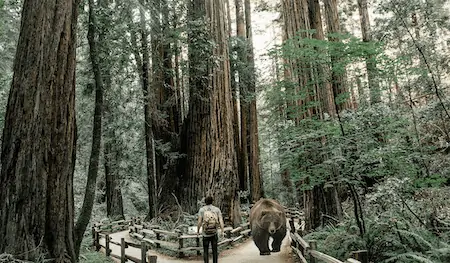Understanding bear behavior is a critical step towards creating a safe environment for both bears and humans. To understand their behavior, you should interpret bear vocalizations and postures based on what they fear.
Since bear behavior is predictable, it helps you react appropriately whenever you see them avoid negative encounters. Take note that bears aren’t malicious; rather, they’re shy animals with little desire to be close to humans unless their search for food leads them to a source near human beings.
Just like other animals and humans, bears have a critical space that they defend. If anyone or anything enters that space, they’re forced to react by either running away or becoming aggressive. Since bears aren’t always aware of what’s around them, they might bump into unsuspecting humans.
7 Advance Preparations for Bear Encounters
Considering that you can unexpectedly run into a bear, knowing how to react or handle the situation can save your life. Here’s how you can prepare for bear encounters.
#1. Go for Training
A bear encounter can be lethal if mismanaged. This is why taking bear awareness safety training can help you avoid potentially dangerous grizzly and black bears, which is especially true if you’re working close to their habitats.
A bear safety training teaches you how to handle an encounter when it becomes inevitable. During the bear awareness training, you’re taught how to identify dangerous bear behaviors, how to respond to emergencies, and how to use protective equipment.
This training is ideal for employees who work near or around bear habitats and others who know that their duties will sometimes require traveling to bear countries. Upon completing the course, you should know what kinds of bears are most dangerous and the strategies you can use to avoid an encounter.
Additionally, you must also be able to choose the proper protective equipment when preparing to visit a bear country to ensure your safety and that of your co-workers.
#2. Buy Bear Sprays
Bear spray is the most effective deterrent in bear encounters instead of shouting, avoiding dense bushes, and any other safety measure that comes across your mind.
A bear spray is a strong-smelling capsaicin spray that, once sprayed, a bear will back off to avoid the burning sensation in its eyes and nose. Before you have the chance to use it on a real bear, practice removing the safety cap and learn how to spray it.
To effectively use a spray in a dangerous situation, remove it from its safety straps and assess the wind’s direction to ensure the spray doesn’t blowback to you.
Once the bear is 30 feet away or less, start spraying. If it continues to charge while coming closer, keep spraying until it retracts, then go away in the opposite direction.
#3. Learn Causes of Bear Attack
Other than attacking to defend itself or as predatory aggression, a bear will attack when startled or surprised and when a human gets too close to its food or food source.
Females with cubs are incredibly aggressive and can dive to defend their cubs if faced with a possible threat. Additionally, if you encounter a bear, then start running; it sees you as prey and chases after you.
#4. Learn How to React
Since most bears are only keen on protecting their space, food, and cubs, their attacks are rare. However, preparing yourself mentally with an adequate response no matter the type of bear that attacks you can save your life.
If a brown or grizzly bear attacks you, lie flat on your belly with hands interlocked to protect your neck and play dead. Consider spreading your legs to make it difficult for the bear to turn you over and stay still until the bear leaves.
When you encounter a black bear, and it attacks, try escaping to a safe place. If you can’t run, defend yourself with any object within your reach and concentrate on the bear’s face and muzzle.
#5. Know Bear’s Body Language
If a bear stands on its hind feet, it’s usually trying to get a better look or sniff the air. This posture isn’t aggressive, and it could mean that the bear isn’t aware of what is around it.
If it swings its head from side to side or turns away from you, it’s a sign that it’s reluctant to charge and is looking for a way out. When a bear looks directly into your eyes with its ears back or makes woofing, barking, or moaning sounds, it’s a warning that you’re in its space, and it feels threatened.
Additionally, a bear that pops its jaws is usually very agitated, and it mostly charges for trying to resolve a situation. This is often a bluff charge that may happen a few times before the bear goes away.
However, do note that a bear may bluff charge and then will attack you from a different angle.
#6. Learn to Deal with Danger
If you sense that a bear can attack you at any moment, stay calm, quiet, and avoid making sudden movements. Don’t stare into the bear’s eyes, as that can be a sign of aggression.
Stand your ground and avoid turning your back on the bear. Have your spray ready but don’t use it unless you’re sure the bear is close enough to spray on its face.
Look out for signs of aggression and agitation, then slowly move back while speaking in a calming tone. Doing so will show the bear that you’re submissive and ready to leave its territory.
#7. Learn to Avoid Bear Encounters
The first line of defense against bear attacks is avoiding an encounter with them. First, research the area you’re visiting and find out if there have been any bear attack incidents recently.
This way, you can find ways to avoid that specific area and prepare for a potential attack. If you’re walking or hiking, beware of your surroundings, hike in groups, and stay together.
When camping, avoid keeping food in your tent, as bears have a strong sense of smell. Cook far away from your tent and thoroughly clean the area so you won’t attract bears. Also, consider making your tent bear-proof.
Endnote
Preparing for bear encounters ensures your safety and that of your loved ones. Consider using the above tips when getting ready to visit a bear country, and don’t forget to get a bear horn.



